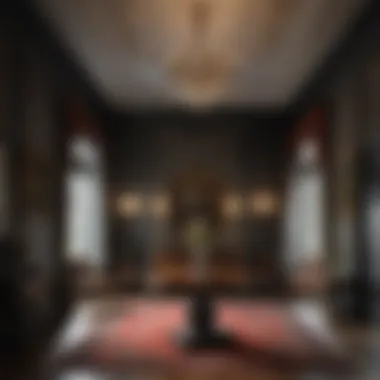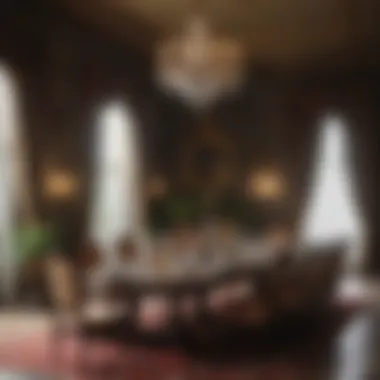Blair House: A Historical Insight into Diplomacy


Intro
Blair House holds a prominent place in the narrative of American hospitality and diplomacy. Located near the White House, it is not only a guest house for distinguished visitors but also a monument to the traditions and the evolution of U.S. foreign relations. This series explores the historical significance of Blair House, its architectural features, and the protocols governing its use.
Understanding the great depth of this establishment enables a broader perspective on the nature of diplomacy today. From the early days of its creation to its role in contemporary discussions, Blair House stands at the intersection of welcome and state affairs.
This examination reveals its notability in a context that extends beyond mere accommodations for international figures. Notably, visiting dignitaries are welcomed here not just for meetings, but for the shared experiences that help to foster understanding and collaboration among nations.
The following sections will detail the historical evolution of Blair House, its architectural significance, and how it continues to shape both hospitality and diplomacy in the United States.
Prologue to Blair House
Blair House stands as a significant symbol in the realm of diplomacy and hospitality for the United States. Situated across from the White House in Washington, D.C., it is the official guest house of the U.S. State Department. Its role extends beyond mere accommodation; it serves as a platform for hosting dignitaries and fostering international relations. Understanding its historical context and functional importance provides insights into how the U.S. engages with the world.
Definition and Purpose
Blair House is defined as the official guest residence for visiting foreign dignitaries. Its primary purpose is to provide a secure and comfortable environment for leaders during their stay in Washington. Here, guests can engage in discussions that may shape international policies. This space promotes an atmosphere of hospitality that aligns with American values in diplomacy.
The significance of this guest house is two-fold. Firstly, it aids in building rapport between nations. Secondly, it reflects the commitment of the U.S. to uphold an image of openness and collaboration. Guests not only experience U.S. culture but also participate in meetings that can lead to significant agreements and partnerships.
Historical Background
Blair House was constructed in the 1820s and has undergone numerous changes over the decades. Initially built as a private residence, its transition into a governmental guest house marked a pivotal moment in its history. In 1942, President Franklin D. Roosevelt officially designated Blair House as the State Department's guest residence. Since then, it has hosted countless high-profile visitors, including heads of state and influential figures from various sectors.
The building has witnessed major historical events. From intimate dinners to formal meetings, it has facilitated discussions that have influenced global politics. Each room has its own narrative, reflecting the blending of historical significance and modern diplomacy. In preserving its legacy, the U.S. continues to maintain Blair House as a vital asset in international relations.
Architectural Features
The architectural features of Blair House are integral to its role as both a guest residence and a historical landmark. They reflect the evolving aesthetics of various periods and highlight the intersection of functionality and elegance. Understanding these features offers insight into how design influences hospitality and diplomacy.
Exterior Design
The exterior of Blair House embodies classic Federal architecture, notable for its red brick façade. The symmetry of its design is striking, with well-placed windows and an emphasis on proportion. The grand entrance is framed by a portico supported by columns, architecturally inviting guests into the space. This blend of grandeur and grace serves to elevate the status of the house, aligning with its purpose as an official guest house.
The roof, adorned with slate shingles, conforms to traditional designs but is complemented by modern maintenance techniques that preserve its structural integrity. Notably, the exterior's paint and trim are kept in muted colors, thereby maintaining a dignified appearance in keeping with the house's important function in diplomacy.
One unique aspect is the presence of detailed cornices and friezes, which showcase the craftsmanship common in buildings of this historical period. These elements not only add aesthetic appeal but also tell a story of the architectural trends of the late 18th and early 19th centuries.
Interior Layout
Inside Blair House, the layout reflects a balance of formality and comfort, tailored for hosting dignitaries and international guests. The grand hall serves as a focal point, linking various rooms while allowing for simultaneous gatherings. This design maximizes spatial efficiency, enabling fluid movement between rooms during events.
The ballroom stands out with its high ceilings and intricate moldings. It is ideal for formal receptions, presenting an ambiance of sophistication. An adjacent dining room is equally impressive, featuring a long table that can accommodate large affairs, essential for diplomatic discussions.
Private suites are designed with guest comfort in mind, often incorporating personalized touches. Each suite reflects a subtle yet luxurious atmosphere to ensure guests feel welcomed. The interior decor, featuring historical artwork and classical furnishings, not only adds character but also reinforces the house as a site of American heritage.
Landscaping and Grounds
The grounds surrounding Blair House play a significant role in enhancing its architectural features. The meticulously landscaped gardens offer a serene environment, carefully designed to complement the house’s exterior. Mature trees provide natural shade, while flower beds introduce vibrant colors, enriching the surroundings without overwhelming the structure.


Paths lead visitors through various sections of the garden, ensuring accessibility while promoting a leisurely experience. The layout encourages visitors to appreciate both the natural beauty and the dignified presence of the house.
"Sweet gardens often provide the much-needed tranquility in a residence meant for the world’s leaders."
The fencing and surrounding walls, designed to maintain privacy, also add a layer of security necessary for high-profile guests. Additionally, the integration of historical artifacts within the landscaping—like sculptures and fountains—enhances the cultural significance of the grounds, making them not merely decorative but educational as well.
In summary, the architectural features of Blair House reflect a deep sense of history and purpose. Through careful attention to detail in the exterior, interior layout, and landscaping, the house serves not just as a residence but also as a ceremonial space for diplomacy. This harmonious blend of aesthetics and functionality continues to represent the values of hospitality and distinguished service.
Historical Significance
Blair House holds a prominent position in the context of American history and diplomacy. Its significance transcends mere architecture and hospitality; it serves as a tangible representation of U.S. foreign relations and the country’s commitment to global dialogue. By analyzing the historical context, one can appreciate how such a venue facilitates international cooperation and understanding.
Establishment as a Guest House
The origins of Blair House date back to the early 19th century when it was constructed as a private residence for a prominent local family. Over time, it shifted ownership and eventually found its place in history as the official guest house for the United States government. Designated a guest house in 1942, it has since become a site for hosting numerous international visitors, serving particularly as accommodation for foreign dignitaries and heads of state. This transformation highlights a strategic decision to use a distinctive venue that embodies American hospitality and charm.
The choice of Blair House for such a function was deliberate. It is centrally located near the White House, presenting an accessible option for diplomatic engagements. Additionally, the house has been refined over the years, providing modern amenities while retaining its historical charm. This integral blend makes Blair House an apt representation of the United States—rooted in tradition yet advancing with contemporary needs.
Memorable Events and Meetings
Throughout the decades, numerous notable events and meetings have taken place within the walls of Blair House. From hosting state dinners to informal meetings, the significance of these events cannot be overstated. For instance, the discussions held here often pave the way for crucial diplomatic agreements. The location provides an intimate setting, allowing leaders to build rapport and address common interests.
"In diplomacy, the setting often plays as important a role as the discussions themselves. Blair House’s ambiance fosters trust and cooperation."
High-profile gatherings at Blair House have included discussions surrounding treaties and international collaborations. Moreover, informal meetings can lead to significant outcomes that shape international relations. This underscores how the guest house is not merely a place to sleep but a venue where major political decisions can unfold.
In summary, the historical significance of Blair House is a multifaceted aspect of its identity. From its establishment as a guest house to its role in high-stakes meetings, it demonstrates the essential connection between hospitality and diplomacy. Understanding these elements sheds light on the broader narrative of American foreign relations.
Blair House in Diplomacy
Blair House serves as a significant venue for diplomatic relations. As the official residence for international guests of the U.S. State Department, it operates beyond the defined role of a typical guest house. The space is a symbol of the United States' commitment to hospitality and diplomacy. Through various events and meetings hosted here, Blair House has facilitated numerous critical dialogues between global leaders and U.S. officials.
Functions and Uses
The functionalities of Blair House span multiple purposes. It caters to heads of state, dignitaries, and important delegations visiting America. The house is not merely a place to stay; it is an active venue for discussions of international importance.
- Official State Visits: Blair House is the home for visiting heads of state. Their stay includes formal events. These often are both private meetings and public engagements.
- Negotiations: Significant treaties and agreements are often discussed within these walls. The setting promotes a conducive environment for important talks.
- Cultural Integration: Events at Blair House often showcase diverse cultures, enhancing mutual understanding among diplomats.
Cultural Exchanges
Cultural exchanges frequently take place at Blair House. The residence hosts a variety of events that foster connections between different cultures. These engagements often feature art exhibitions, music performances, and culinary showcases.
- Art Installations: The house often showcases works from various artists, reflecting the cultural diversity of the United States.
- Culinary Diplomacy: Meals served often highlight American cuisine alongside dishes from visiting dignitaries' countries.
- Performing Arts Events: By incorporating music and performances into gatherings, Blair House presents a microcosm of cultural exchange.
Impact on International Relations
Blair House plays an influential role in shaping international relations. Many pivotal moments in U.S. diplomacy have occurred on its premises. The setting has facilitated a nuanced understanding of global politics.
- Building Bilateral Relationships: The informal environment allows for open dialogue. This setting often helps to establish long-term connections between the U.S. and other countries.
- Conflict Resolution: Meetings held here can smooth over tensions. Leaders are more at ease, leading to constructive discussions even in times of strife.
- Public Perception: The image of occasional hosts being night at the Blair House signifies friendship and collaboration. This contributes positively to the international image of the U.S.
Blair House is not just a residence; it is a cornerstone of American diplomacy, where cultures meet and important relationships are built.


Notable Guests
Blair House stands out not only for its architectural elegance but also for its significant role in hosting key figures across diverse spheres. The guests at Blair House often represent the pinnacle of politics, culture, and history, each bringing a unique narrative that deepens the understanding of American diplomacy. The significance of notable guests lies in their capacity to bridge cultures, foster relationships, and showcase the essence of international cooperation.
World Leaders
World leaders who have graced the halls of Blair House are a testament to its stature in global diplomacy. Figures like Winston Churchill and Nelson Mandela have taken residence, each forging connections that have shaped political landscapes. For instance, the lodging of leaders during high-stakes negotiations exemplifies how Blair House transcends a mere guest house; it serves as a stage for diplomacy in action. These encounters facilitate face-to-face discussions, often leading to historic agreements that impact global policies.
Hosting leaders also reinforces the United States' commitment to international relationships. When a president invites another country's head of state to stay, it sends a strong message of cooperation and respect. These visits often span crucial topics—trade agreements, military alliances, or environmental initiatives—highlighting the multifaceted nature of diplomacy.
Cultural Icons
Cultural icons at Blair House serve to underline the intersection of diplomacy and culture. Whether it is artists, writers, or musicians, their presence enriches the narrative of international relations. For example, when prominent musicians like Yo-Yo Ma have been hosted, it is not simply about entertainment but involves fostering cultural dialogue. These figures encourage a broader understanding and appreciation of different cultures, further enhancing diplomatic relations.
Their engagements often include performances that celebrate the diversity of global heritage. Such events create a unique environment where art and diplomacy converge, revealing shared values and histories. This cultural diplomacy expands the impact of bilateral relations beyond politics, enriching the cultural fabric of both nations involved.
Historical Figures
The impact of historical figures who have stayed at Blair House cannot be overstated. From diplomats to philosophers, each guest represents a piece of history. Figures like Eleanor Roosevelt not only stayed in this historic residence but also engaged in discussions that influenced pivotal policy changes. Their visits create a legacy that informs contemporary discussions on diplomacy and international relations.
These historical figures bring firsthand experience and perspectives that can adjust the thinking of current leaders. Each visit contributes to the complex tapestry of American and world history, allowing guests to share insights that resonate beyond their time. The stories that emerge from these stays often reflect the challenges and triumphs of their respective eras, offering lessons that remain relevant today.
"Blair House serves as more than just a residence; it is a crucible where ideas are exchanged and relationships are forged across borders."
In summary, notable guests give unique depth to Blair House's identity as a diplomatic space. Their presence underscores not only the formalities of international relations but also highlights the lasting impact of personal connections on a global scale.
Preservation Efforts
Preserving Blair House is not merely a matter of maintaining a historical building; it entails safeguarding a rich narrative that embodies U.S. diplomacy and hospitality. The need for preservation goes beyond aesthetic concerns. The importance lies in honoring the stories of significant political meetings and cultural exchanges that have taken place within those walls. When visitors step into Blair House, they are not only entering a residence, but also experiencing a living museum of American history.
Renovations and Upkeep
Blair House has undergone various renovations to ensure its continued functionality. Regular upkeep is essential to maintain the integrity of its architectural features. These renovations focus on modernizing facilities while respecting historical elements. For instance, wiring and plumbing updates have been necessary to meet contemporary standards without compromising the building's historic charm. The balance between maintaining historical accuracy and accommodating current needs is always a key consideration during renovation projects.
Here are some key points regarding renovations:
- Historical Accuracy: Efforts are made to use materials and techniques consistent with the original construction.
- Modern Amenities: Upgrades include contemporary utilities while preserving the vintage style.
- Safety and Accessibility: Renovations also aim to enhance safety features and improve accessibility for guests.
Historical Preservation Organizations
Several organizations are dedicated to the preservation of Blair House. These bodies play a crucial role in implementing conservation strategies. They advocate for funding, support public awareness, and ensure compliance with preservation guidelines.
These organizations include:
- National Trust for Historic Preservation: They provide resources and funding for projects to maintain historic sites across the country.
- The Advisory Council on Historic Preservation: This group ensures that federal project decisions consider heritage conservation.
- Local Historical Societies: They often offer support and advocacy for preserving structures within their communities.
Through collaboration with these organizations, Blair House can maintain its status as a historically significant site. Such partnerships are vital in fostering a deeper understanding of preservation's role in American cultural heritage.
"Preserving historic places offers insights into our past and informs our future."


In summary, preservation efforts at Blair House reflect more than the care of bricks and mortar; they capture the essence of diplomacy and history. Such endeavors ensure that future generations can connect with a pivotal part of America's diplomatic narrative.
Public Access and Tours
Public access to Blair House is an important aspect of its role as not only a guest house but also a site of historical significance. Tours of Blair House offer a unique glimpse into the diplomatic history of the United States and its architectural heritage. By opening its doors to visitors, Blair House serves a dual purpose: it acts as a residence for distinguished guests and as a historical exhibition space that educates the public about its storied past.
Tour Information
Visiting Blair House can be a unique experience. The official tours are typically conducted on specific days and require advance arrangements. These tours provide an informative overview of both the building's history and its function in American diplomacy. Visitors will see several key rooms, including the formal reception areas, dining rooms, and some guest quarters.
Some important elements regarding the tour include:
- Advance Reservations: Tours often require prior booking due to limited spots, especially for groups.
- Duration: Most tours last about 45 to 60 minutes, providing a comprehensive insight into the workings of the house.
- Guidance: Knowledgeable staff guide guests through the rooms, sharing fascinating anecdotes and historical context.
Visitors may find that experiencing the atmosphere of Blair House offers a deeper understanding of the place where many significant diplomatic interactions have occurred.
Visitor Guidelines
To ensure an enjoyable visit, Blair House has specific guidelines that visitors should comply with. These rules help maintain the integrity and decorum of such a prestigious setting. Key guidelines include:
- Respect the Environment: Visitors should maintain silence in certain areas to preserve the ambiance of the house.
- Behavioral Standards: Appropriate behavior is mandatory, reflecting the significance of the house as a diplomatic space.
- Photography Restrictions: Some areas may prohibit photography to protect privacy and the historical integrity of artifacts.
Lastly, it is always wise to check the latest visitor guidelines before planning your trip to ensure a smooth experience. By adhering to these recommendations, visitors contribute to the respectful appreciation of Blair House and its historical importance.
Comparative Analysis of Guest Houses
In understanding the role of Blair House, it is essential to explore how it compares to other guest houses around the globe. This comparison highlights unique features, functionalities, and cultural significances that shape how such establishments serve their nations. Recognizing these elements not only enriches the comprehension of Blair House's place in history but also situates it within a broader context of diplomacy and hospitality.
Global Examples
Different nations have established their own guest houses for hosting dignitaries, and each reflects local traditions and customs. A few notable examples include:
- The White House in Washington D.C.: Although primarily a residence for the President, it also serves as a guest house for visiting leaders, showcasing American history and governance.
- The Élysée Palace in Paris, France: This grand home of the French President hosts state visits, featuring elegant decor that merges history with modern politics.
- Chequers in Buckinghamshire, England: The official country residence of the British Prime Minister provides a more informal setting for hosting international guests.
- Palácio da Alvorada in Brasília, Brazil: Designed by Oscar Niemeyer, this modernist structure serves as the official residence and a guest house, symbolizing Brazilian architecture and culture.
These examples demonstrate the diversity in design, purpose, and cultural relevance present in guest houses worldwide. Each site outlines the characteristics of its nation while fulfilling similar diplomatic functions.
Distinctive Features of Blair House
Blair House stands out with its own set of distinctive features that cater specifically to its role in U.S. diplomacy. Key elements include:
- Architectural Heritage: Blair House showcases a mix of federal architectural styles, dating back to the 19th century, making it a historical artifact in its own right.
- Multifunctional Spaces: The layout is designed not just for residential purposes; it includes various meeting rooms and entertainment areas for formal gatherings and informal discussions.
- Cultural Richness: Through time, Blair House has been adorned with significant works of art and historical artifacts, enhancing its stature as a cultural as well as a political hub.
"Blair House is more than just a residence; it is a bridge between cultures, providing a platform for dialogue and understanding."
The importance of Blair House as a guest house can be appreciated through this analysis, revealing how it integrates various functions and maintains its significance in modern diplomacy. Its character and service as a vital meeting point enrich both the guests' experiences and the U.S.'s relationships with other nations.
Ending
The conclusion serves as a critical component in this article about Blair House. It provides a final synthesis of the insights presented and emphasizes the significance of the guest house in the landscape of American diplomacy. By summarizing key points, the conclusion not only reinforces the historical and architectural importance of Blair House but also highlights its ongoing relevance in contemporary international relations.
Summary of Insights
Blair House has evolved from its original role as a residence into a crucial site for diplomacy. This article explores various facets such as its architectural features and the notable figures who have visited. The guest house acts as more than a place for hospitality; it has become a symbol of the United States' commitment to fostering international relations. The insights derived from examining Blair House demonstrate how architecture and culture can intersect to create environments conducive to dialogue and understanding among nations.
Future of Blair House
Looking ahead, the future of Blair House appears multifaceted. As global dynamics change, the guest house will likely continue adapting to meet modern diplomatic needs. Additionally, preservation efforts will become increasingly important to maintain its historical integrity while accommodating contemporary functionalities. Through continued public engagement and tour opportunities, Blair House can educate future generations about the role of diplomacy. It is crucial that this iconic structure remains a vital part of the narrative surrounding U.S. foreign relations for years to come.



